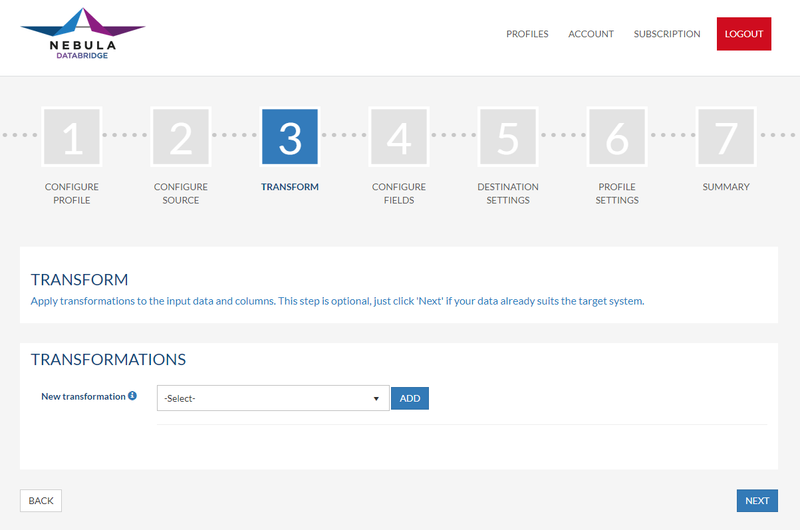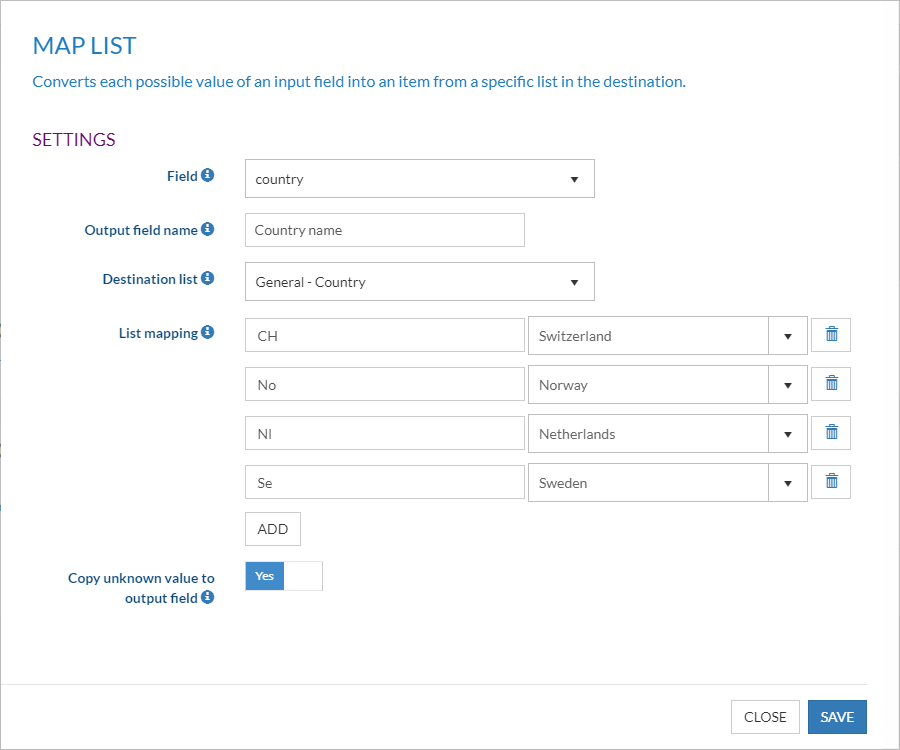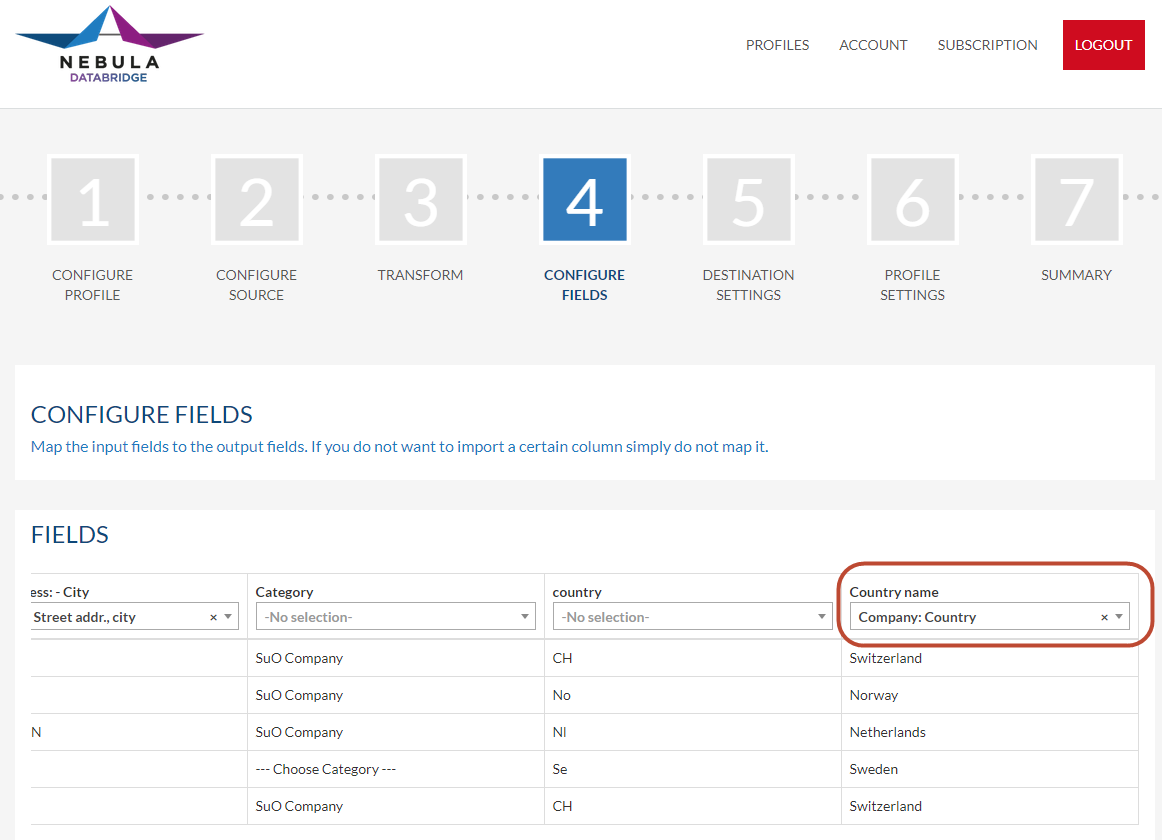Overview
DataBridge supports transformations for import and export files. Data transformations can be added to import and export jobs.
Click here to view the article on Transformations for DataBridge Export.
How to
Create a new profile or edit an existing profile by clicking Manage profile. On the Transform page, select the Transformation you want and click Add.
The options to choose from are
Create a new field with the value of the selected field. When the value of that field is empty, the value of the fallback field will be used. | |
Add field | Add a new field with a fixed value. |
Append text value | Allows prepending and appending text to field values |
Clean field | Cleans a text field using a specific cleaning option. All cleaning options include white space, commas and periods. |
Copy field | Can be used for when you want one field from the source to map to multiple fields in the destination (for example: address which can be both visit and postal). |
Current date time | This transformation can be used to fill a field with the current date and time |
Format text value | Formats the value in the field. |
| Map list | Converts each possible value of an input field into an item from a specific list in the destination. |
Merge fields | Merges the input fields into newly defined output fields. |
Remove fields | Prevents the selected fields from appearing in the output. |
Rename field | Renames the title of the field and leaves the value unchanged. |
Replace | If the field matches the specified value it will be replaced by a new value. For example: if the input value is 'OK' it can be replaced by 'TRUE' and used to turn interests on. |
Skip | If the field matches the specified value the record will be skipped |
Split field | Splits a field with a separator and adds a new field with the selected segment(s) You can find a detailed description of this transformation here |
The added transformations can be edited or removed at any time, see below.
NOTE: If you are adding transformations to an existing profile with mappings in place and choose to use the Rename field transformation you will see the message as shown in the picture below.
This means that mapping is no longer valid, due to the renaming.
This can easily be fixed by clicking the Remove Invalid Mapped Fields button and map the field to the correct field.
THE OUTPUT RESULTS
Add conditional field
Create a new field with the value of the selected field. When the value of that field is empty, the value of the fallback field will be used.
For instance, you have an import file with data from two different external systems. In it there are two number columns, now you can say basically: when column 1 has records import those, when empty choose column 2.
Add field
For our import, we have chosen to add a field Code with a fixed value 123.
The result can be seen on the Configure fields page.
Append text value
The “Append text value” transformation allows for prepending and appending text to field values.
Clean field
In the example below, we have chosen the transformation 'Clean field' to clean the column with phone numbers. As clean option the Clean Number field is selected.
In the Configure Source page you can see the phone numbers and on the Configure Fields page you can see the result of the transformation, the non-digit characters are removed.
Copy field
The Address field from the Import file will also be used for the postal address. This can be achieved by choosing the Copy Field transformation.
The result can be viewed on the Summary page. The Address column from the import file can be used twice.
Current date time
This transformation can be used to fill a field with the current date and time.
In this example, we will fill a user-defined field with the latest update by DataBridge.
First, choose the Transform 'Current date time' and fill in a field name.
The next step is to map the new field to a SuperOffice field. In this example, we use a User Defined Field called 'DataBridge Import Date'.
After running the Import job, the current date and time are filled in in the Udef of SuperOffice.
Format text value
With Format text value you can format the values in the chosen field. There are a couple of format options.
As an example let's use 'hello YouTube'
| Upper case | All in upper case | HELLO YOUTUBE |
| Lower case | All in lower case | hello youtube |
| Capitalize first | First letter in capital | Hello YouTube |
| Capitalize first decapitalize rest | First letter in capital, rest in lower case | Hello youtube |
| Capitalize words | First letter of each word in capital | Hello YouTube |
| Capitalize words decapitalize rest | First letter of each word in capital, rest in lower case | Hello Youtube |
| Trim | Trim will remove all leading and trailing white-space from the value in the fields |
We have chosen the format 'Upper Case' for the Company field. And this is the result in the Configure fields.
Map list
Converts each possible value of an input field into an item from a specific list in the destination. This transformation is an enhancement for the Replace transformation so you do not have to use multiple Replace transformations anymore.
In this example below we want to convert the values in the Country column of the import file.
| Field | Select the field you want to use. In this example Country |
| Output field name | You can name the output field. In this example we choose Country name as output field |
| Destination list | Choose the list which values must be assigned to each input value. You can choose not to select a value and fill in your own values in the list mapping. |
| List mapping | Assign an output value to each input value. In this example we choose the country from the SuperOffice Country list Note: Only the first 15 unique records from the import file will be shown. You can add more manually with the Add button |
| Copy unknown value to output field | Select this option if the field contains a value that is not assigned and it should be copied to the output field. If not, the output field will be left blank |
In the Configure fields page we can now map this new field.
Merge fields
In this example, the fields Address and Number will be merged into a new output field Street address. As a delimiter, a space is used.
On the Configure fields page, you can see the result of the merge.
Remove fields
Prevents the selected fields from appearing in the output. This transform makes the most sense for Export, more info
Rename fields
In the picture below you see the preview of a file with the column header 'Bedrijf'. With the transformation 'Rename field' we want to rename this column header from Dutch to English, to the column header 'Company'
The result can be seen in the Configure Fields page.
Replace
In this example, the values in the column Partner will be replaced when they match the value OK. This value will be replaced with True. This True value can be used to turn on interests in SuperOffice.
On the Configure fields page, you can see the result of the replace transformation.
Skip
With this transformation, you can choose to skip a record when a specified value is matched.
Split field
Splits a field with a separator and adds a new field with the selected segment(s)
You can find a detailed description of this transformation here
























